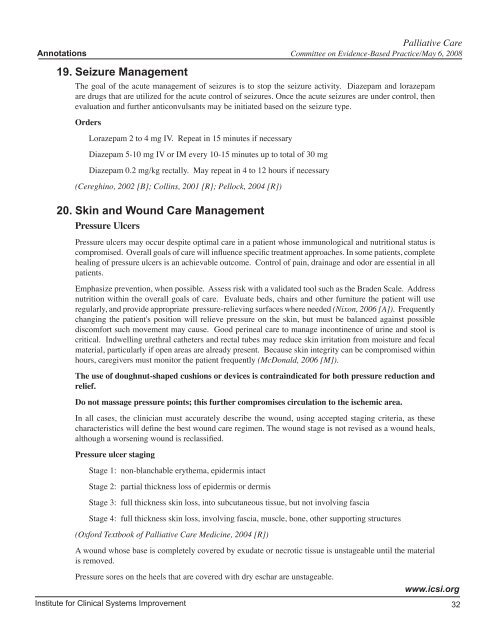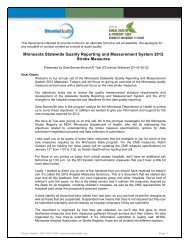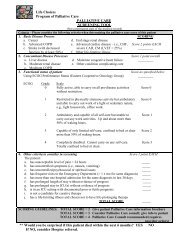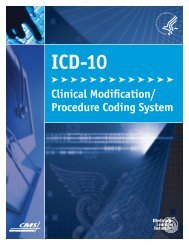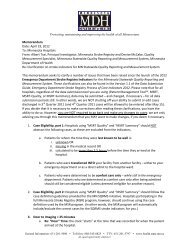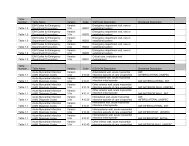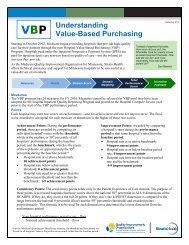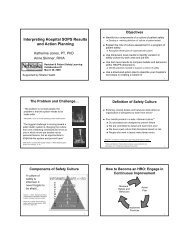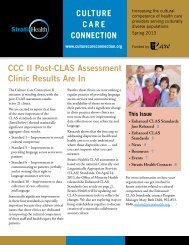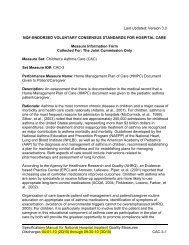Palliative Care Order Set - Stratis Health
Palliative Care Order Set - Stratis Health
Palliative Care Order Set - Stratis Health
You also want an ePaper? Increase the reach of your titles
YUMPU automatically turns print PDFs into web optimized ePapers that Google loves.
<strong>Palliative</strong> <strong>Care</strong><br />
Annotations Committee on Evidence-Based Practice/May 6, 2008<br />
19. Seizure Management<br />
The goal of the acute management of seizures is to stop the seizure activity. Diazepam and lorazepam<br />
are drugs that are utilized for the acute control of seizures. Once the acute seizures are under control, then<br />
evaluation and further anticonvulsants may be initiated based on the seizure type.<br />
<strong>Order</strong>s<br />
Lorazepam 2 to 4 mg IV. Repeat in 15 minutes if necessary<br />
Diazepam 5-10 mg IV or IM every 10-15 minutes up to total of 30 mg<br />
Diazepam 0.2 mg/kg rectally. May repeat in 4 to 12 hours if necessary<br />
(Cereghino, 2002 [B]; Collins, 2001 [R]; Pellock, 2004 [R])<br />
20. Skin and Wound <strong>Care</strong> Management<br />
Pressure Ulcers<br />
Pressure ulcers may occur despite optimal care in a patient whose immunological and nutritional status is<br />
compromised. Overall goals of care will influence specific treatment approaches. In some patients, complete<br />
healing of pressure ulcers is an achievable outcome. Control of pain, drainage and odor are essential in all<br />
patients.<br />
Emphasize prevention, when possible. Assess risk with a validated tool such as the Braden Scale. Address<br />
nutrition within the overall goals of care. Evaluate beds, chairs and other furniture the patient will use<br />
regularly, and provide appropriate pressure-relieving surfaces where needed (Nixon, 2006 [A]). Frequently<br />
changing the patient's position will relieve pressure on the skin, but must be balanced against possible<br />
discomfort such movement may cause. Good perineal care to manage incontinence of urine and stool is<br />
critical. Indwelling urethral catheters and rectal tubes may reduce skin irritation from moisture and fecal<br />
material, particularly if open areas are already present. Because skin integrity can be compromised within<br />
hours, caregivers must monitor the patient frequently (McDonald, 2006 [M]).<br />
The use of doughnut-shaped cushions or devices is contraindicated for both pressure reduction and<br />
relief.<br />
Do not massage pressure points; this further compromises circulation to the ischemic area.<br />
In all cases, the clinician must accurately describe the wound, using accepted staging criteria, as these<br />
characteristics will define the best wound care regimen. The wound stage is not revised as a wound heals,<br />
although a worsening wound is reclassified.<br />
Pressure ulcer staging<br />
Stage 1: non-blanchable erythema, epidermis intact<br />
Stage 2: partial thickness loss of epidermis or dermis<br />
Stage 3: full thickness skin loss, into subcutaneous tissue, but not involving fascia<br />
Stage 4: full thickness skin loss, involving fascia, muscle, bone, other supporting structures<br />
(Oxford Textbook of <strong>Palliative</strong> <strong>Care</strong> Medicine, 2004 [R])<br />
A wound whose base is completely covered by exudate or necrotic tissue is unstageable until the material<br />
is removed.<br />
Pressure sores on the heels that are covered with dry eschar are unstageable.<br />
Institute for Clinical Systems Improvement<br />
www.icsi.org<br />
32


